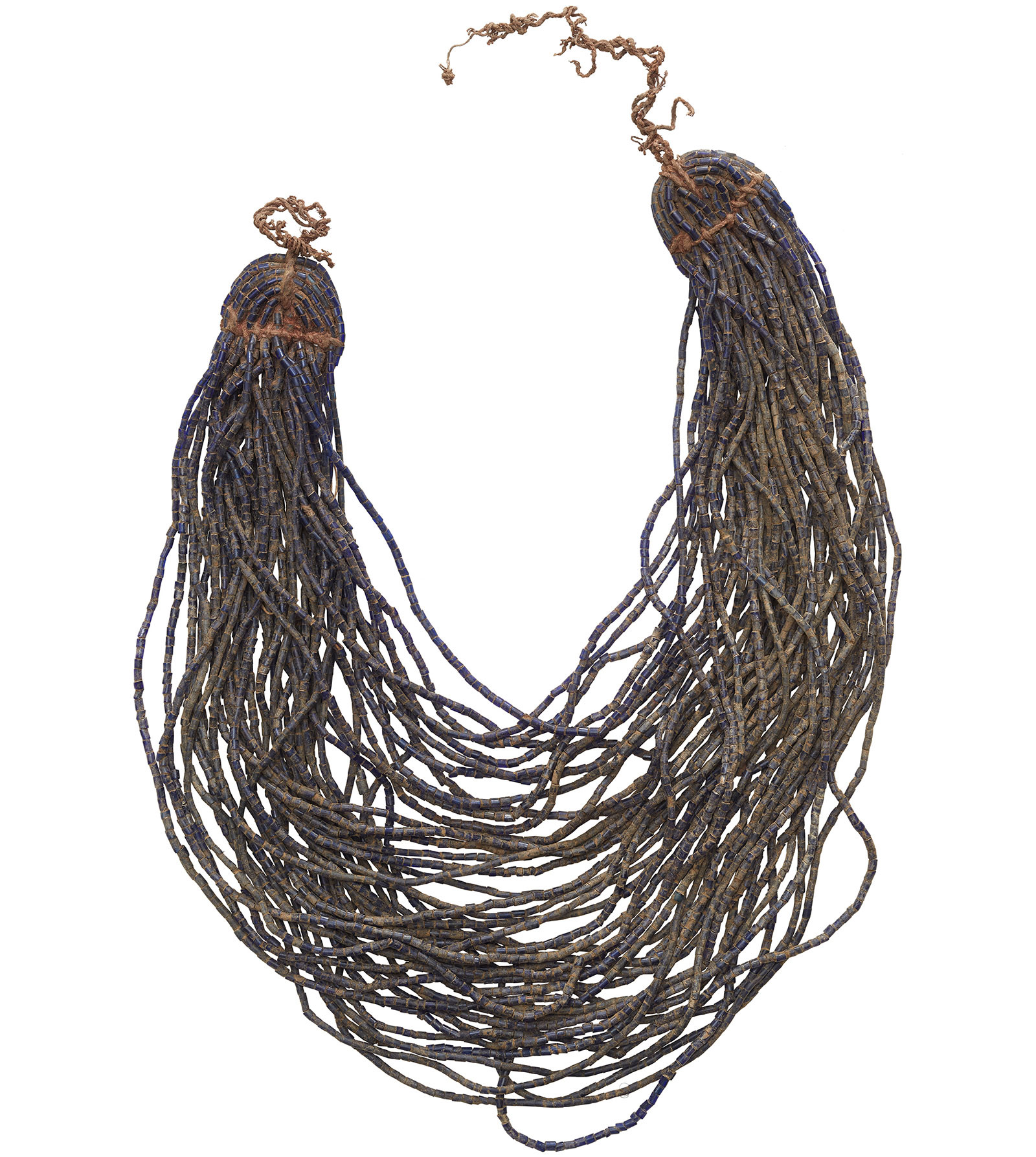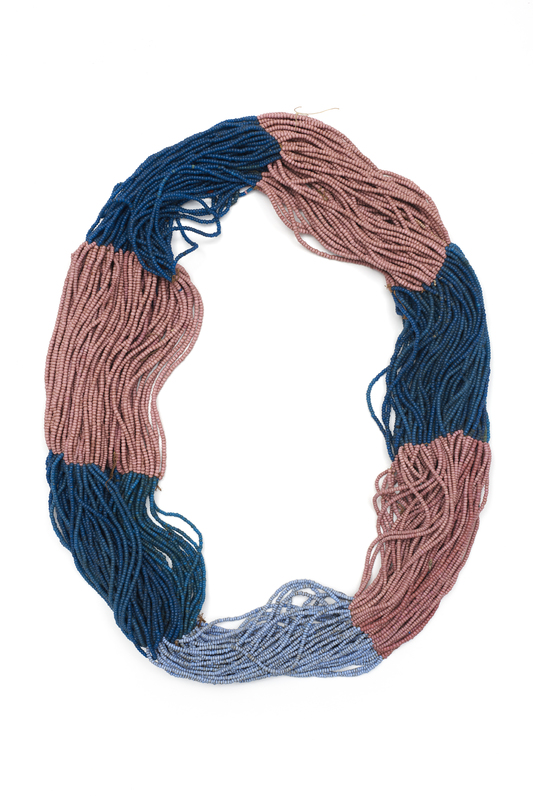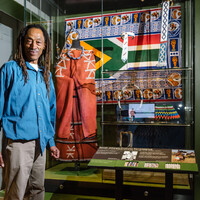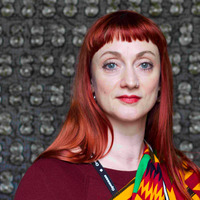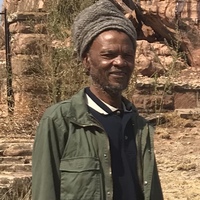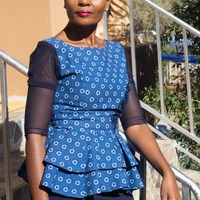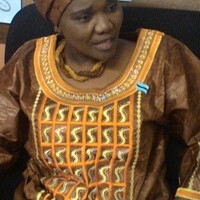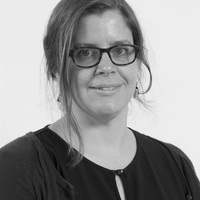Ornament; Belt; Sebaga Sa Letheka
Item
Title
Ornament; Belt; Sebaga Sa Letheka
Creator
Unrecorded
Description
Physical Description: Women's waist ornament made of multiple strings of light blue, dark blue, and pink beads, strung in alternate bands. [Royal Pavilion & Museums]
Contextual Description: worn by a wealthy woman as so many beads. Possibly from the Tswapong Hills area. Notes from Tshepo Skwambane and Neil Parsons initial visit to view objects, 2017
Contextual Description: 01:07:04 He also mentioned another tree, which is like, the name is linked to the name of the village, and the rock he mentioned. Muchachabide it makes like very very hard fruits the fruits harden up for some time and people pierce them to make beads. These kind of beads are used all over, some people would make like necklaces for kids, especially when they are grinding their teeth
Also for young ones around the waist to help give the shape you know? And now he says oh yeah back in the days with the ladies when they are wearing this ah everyone would be wanting to [sight that?] even the woman wearing this kind of beads you would just see the way they walk
RHH: does it enhance the hips and the shape?
SL: Yes
[discussion in Tswana]
SL: He says it would become very very nice if they are wearing their traditional attire with the two aprons. Transcription by KL of MAC_BB_20190817_RPM3 SL Interview with Tshupo Ntono, Village Elder, Language: Setswana with English translations by SL, 2019
Also for young ones around the waist to help give the shape you know? And now he says oh yeah back in the days with the ladies when they are wearing this ah everyone would be wanting to [sight that?] even the woman wearing this kind of beads you would just see the way they walk
RHH: does it enhance the hips and the shape?
SL: Yes
[discussion in Tswana]
SL: He says it would become very very nice if they are wearing their traditional attire with the two aprons. Transcription by KL of MAC_BB_20190817_RPM3 SL Interview with Tshupo Ntono, Village Elder, Language: Setswana with English translations by SL, 2019
Contextual Description: SL 28:02
Yeah beads. I don't know what these were used for really
28:06
They look foreign to me like maybe something [?]
WT 28:12
women's...for around the waist
SL 28:13
aha yeah yeah
WT 28:22
…very sexy, honestly
GK 28:30
they're bulky and
SL 28:40
please, [??] setswana please [Molele se Letheka]
GK 28:50
I'm just thinking that's
SL 28:54
You are right. ... that's how it would be described
GK 28:57
Sebaga how would be like beads Sabaga hi Yeah, bead
JM 28:58
Sebaga is bead?
SL 29:02
No string of beads
JM 29:04
g h a
GK 29:07
g instead of that h yeah. Sa sebaga
SL 29:14
Yes, sa. Sebaga Letheka yeah Letheka Letheka waist - its waist - Letheka
WT 29:27
Waist beads, letheka
29:34
... to make up for them and even if you're from a family that is well off
SL 29:46
again nearly ... to try and achieve that Coca Cola bottle figure
WT 29:52
shaping the waist. waist training
SL 29:56
sisters from this area especially amongst bamangwato They do have that Steatopygia which they borrowed from their khoisan grandmother, even though they're in denial it would sit there nicely because there's something to hold it
WT 30:16
You can put a baby and the baby just sit.
30:22
Yeah.
SL 30:28
Though, yeah, that kind of
WT 30:29
it was exciting looking for suitors, the parents would make sure that you look intriguing
The above notes are from a transcription by Kathleen Lawther of a discussion between Gase Kediseng, JoAnn McGregor, Nicola Stylianou, Scobie Lekhuthile and Winani Thebele which took place at the Khama III Memorial Museum on the 5th of August 2019. To listen to the full recording please follow the link below.
Yeah beads. I don't know what these were used for really
28:06
They look foreign to me like maybe something [?]
WT 28:12
women's...for around the waist
SL 28:13
aha yeah yeah
WT 28:22
…very sexy, honestly
GK 28:30
they're bulky and
SL 28:40
please, [??] setswana please [Molele se Letheka]
GK 28:50
I'm just thinking that's
SL 28:54
You are right. ... that's how it would be described
GK 28:57
Sebaga how would be like beads Sabaga hi Yeah, bead
JM 28:58
Sebaga is bead?
SL 29:02
No string of beads
JM 29:04
g h a
GK 29:07
g instead of that h yeah. Sa sebaga
SL 29:14
Yes, sa. Sebaga Letheka yeah Letheka Letheka waist - its waist - Letheka
WT 29:27
Waist beads, letheka
29:34
... to make up for them and even if you're from a family that is well off
SL 29:46
again nearly ... to try and achieve that Coca Cola bottle figure
WT 29:52
shaping the waist. waist training
SL 29:56
sisters from this area especially amongst bamangwato They do have that Steatopygia which they borrowed from their khoisan grandmother, even though they're in denial it would sit there nicely because there's something to hold it
WT 30:16
You can put a baby and the baby just sit.
30:22
Yeah.
SL 30:28
Though, yeah, that kind of
WT 30:29
it was exciting looking for suitors, the parents would make sure that you look intriguing
The above notes are from a transcription by Kathleen Lawther of a discussion between Gase Kediseng, JoAnn McGregor, Nicola Stylianou, Scobie Lekhuthile and Winani Thebele which took place at the Khama III Memorial Museum on the 5th of August 2019. To listen to the full recording please follow the link below.
Publisher
Making African Connections
Date
Pre 1899
Type
PhysicalObject
Format
Whole: 400 mm x 300 mm x 35 mm x 1016 mm
Glass; Plant fibre; Mongana; Black thorn; Acacia Mellifera
Beadwork
Identifier
R4007/15
Source
Collected by Reverend William Charles Willoughby, a Christian missionary, in what was then the Bechuanaland Protectorate (1885-1966). It is now the Republic of Botswana, having gained independence from Britain in 1966.
From 1889-92 Willoughby was pastor at Union Street Church, Brighton (now The Font pub). From 1893 to 1898 he worked for the London Missionary Society in Bechuanaland. He assembled this collection of objects during this period. This was a period of social and technological changes and these objects represent traditional lifestyles and skills, rather than the contemporary lives of the people Willoughby met.
Willoughby's collection was loaned to Brighton Museum in 1899 when he returned to the UK. The loan was converted into a donation in 1936, and accessioned as acquisition R4007.
Some objects were re-numbered with the WA (World Art) numbering system in the 2000s. These numbers have been reverted to the original R4007/... numbers where possible for consistency in 2019.
From 1889-92 Willoughby was pastor at Union Street Church, Brighton (now The Font pub). From 1893 to 1898 he worked for the London Missionary Society in Bechuanaland. He assembled this collection of objects during this period. This was a period of social and technological changes and these objects represent traditional lifestyles and skills, rather than the contemporary lives of the people Willoughby met.
Willoughby's collection was loaned to Brighton Museum in 1899 when he returned to the UK. The loan was converted into a donation in 1936, and accessioned as acquisition R4007.
Some objects were re-numbered with the WA (World Art) numbering system in the 2000s. These numbers have been reverted to the original R4007/... numbers where possible for consistency in 2019.
William Charles Willoughby
Botswana, Southern Africa, Africa
1893-1898
Space/Place
Botswana, Southern Africa, Africa
Cultural Group: Tswana
Rights
Creative Commons Attribution-ShareAlike 4.0 International
Item sets
Linked resources
Filter by property
| Title | Alternate label | Class |
|---|---|---|
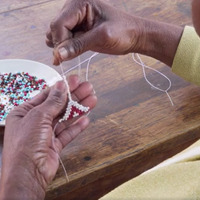 Beadwork Beadwork |

